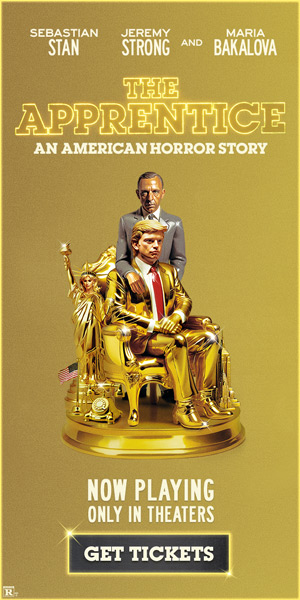The Dukes of Hazzard is killing ’em in the boonies but not as much in the big blue cities. It did $11.9 million on Friday, and will probably wind up with $32 or $33 million for the weekend, but it’s playing “very rural,” I’m told. Whatever…that’s a pretty good haul for a film as atrociously bad as this one. Meanwhile, Jim Jarmusch’s Broken Flowers is doing very nicely for an upscale urban film. Playing in only 27 theatres, it brought in $207,500 yesterday at $7688 per screen. That’ll probably translate into $700,000 for the weekend. That’s good money for a film of this sort.
Too Brainy
There’s a reason Jay Chanderasekhar’s Super Troopers (2001) caught on — the absolute go-for-broke, beyond-hope stupidity of the characters. A similar thing worked for the Farrelly’s Dumb and Dumber and, going way back, Bill Pullman’s “Earl Mott” character in Ruthless People
If you really get it, deep-down genetic stupidity can be hilarious. And I don’t mean stupid-but-cool and not cleverly stupid and not uneducated but street smart…I mean, forget-about-it brontosaurus dumb. But you have to go all the way, and that’s what Chanderasekhar didn’t do when he shot The Dukes of Hazzard.
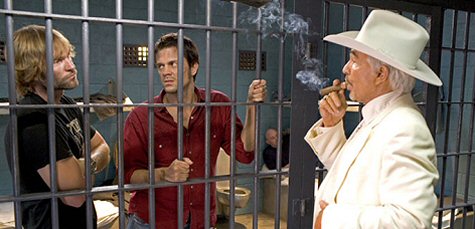
The Dukes of Hazzard costars (l. to r.) Seann William Scott, Johnny Knoxville, Burt Reynolds.
The characters of Bo Duke (Seann William Scott) and his brother Luke (Johnny Knoxville) are garden-variety yeehaws. But they’ve also been given a certain country dignity, and that’s what’s unfunny about this deeply painful film — the effort to try and put these guys over as likable rascals.
They need to be dribbling-saliva stupid but of course, that would be insulting to rural Southern audiences and the fans of the TV series, etc.
I’ll bet anyone a dozen corndogs that the producers (Bruce Berman, Bill Gerber, et. al.) said to Chanderasekhar, “We loved Super Troopers, but a lot of people love the TV series, so don’t make these boys too retarded….right? They’re ballsy guys…not too smart but cool and brash and all that. You know…round `em out a bit.”
< ?php include ('/home/hollyw9/public_html/wired'); ?>
So they made a shit movie that got a 25% positive rating on Rotten Tomatoes. And lots of people are going to shell out to see it this weekend. Hooray for Gerber and Chanderasekhar and the rest of the crew.
But Seann William Scott has pushed things right to the limit. He’s played the same spirited moron in 10 or 11 films over the last six years or so, and sooner or later audiences get sick of it and when they finally do you’re over. Scott is lucky…make that very lucky…that Richard Kelly has cast him in a mostly sober part in the currently shooting Southland Tales.
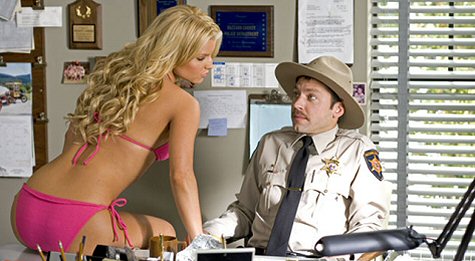
The thing that Jessica Simpson had (describe it any way you like) is now, with the debut of The Dukes of Hazzard, worth a good deal less.
Every critic in the country has gone to town with this thing, but two guys from Arizona — Phil Villarreal of the Arizona Daily Star and Bill Muller of the Arizona Daily Republic — are my favorites.
I especially like Villarreal’s comment, to wit: “Hell, suck the exhaust fumes from a 1969 orange Dodge Charger. But whatever you do, no matter how big a fan you were of the show, do yourself a favor by skipping this movie.”
In The Pudding
Seeing the smartly engaging Proof (Miramax, 9.16) right after The Dukes of Hazzard felt like a spring rainfall washing away toxic chemicals.
Directed by John Madden (Shakespeare in Love), Proof is an earnestly delivered, well-written intellectual drama — you can feel the structural discipline of David Auburn’s play all through it — with a title and theme that doesn’t just apply to mathematics.
I never saw Proof on Broadway but I know of its reputation, and I can understand where all the praise came from.
The film has some weak aspects, okay, but it’s certainly not flawed enough to have justified Miramax’s decision to shelve it last fall, or roughly eight or nine months ago. The research scores weren’t spectacular, I’m told, due to Gwynneth Paltrow’s remote and chilly performance, but it’s obviously an impassioned quality-level thing that will send no one out into the street feeling burned.
Why didn’t Harvey just release it and give it a shot? It’s far from an embarrassment. Smart, well crafted, food for thought. Why taint it by shelving it?

Gwynneth Paltrow, Jake Gyllenhaal in second-act scene from John Madden’s Proof
Madden called this morning and says Proof was pushed aside last year so Miramax could devote more time to pushing Miramax’s two big Oscar contenders, The Aviator and Finding Neverland, and that once the end-of-the-year slot was gone he insisted on a fall ’05 debut rather than a winter or spring opening.
Proof is about the cloistered world of mathematics scholars and a recently passed-away professor named Robert (Anthony Hopkins), once a genius-level pathfinder who lost his grip on sanity when he entered middle age.
The story is about his daughter Catherine (Paltrow) coping with the possibility that she may inherit his insanity, and particularly how to deal with a discovery in a notebook that Robert may have had a late-inning surge of brilliance and come up with a mathematical proof that will re-order everything. Simultaneously urging her forward and pitching woo is a young math student named Hal (Jake Gyllenhaal).
How do you prove love to someone you say you love? By trusting them absolutely, Auburn says. To question them, to ask for rationality or practicality is not love…it’s the lack of faith that ruins a love affair. This may well be true, but there’s a scene between Paltrow and Gyllenhaal in which this view is, I feel, insufficiently felt and invested in.
Paltrow’s Catherine is such a sourpuss, such a “no” person, such a killjoy that you almost want to ally yourself with her tedious sister Claire (Hope Davis), but she’s such a mediocre and unimaginative prig that you can’t help but recoil.
The one you support and identify with the most, of course, is Hal, a hopeful, positive, fully-engaged fellow. This is Gyllenhaal’s most winning character ever. For once — finally! — he’s not playing a withdrawn neurotic wearing a pained, woe-is-me expression.

But we should identify with and want to support Paltrow more — she’s carrying this thing on her back, bearing the burden — and while I found her performance believably lived in and particular and behaviorally convincing for the most part (Paltrow played the role in a play performed in London), I found it hard to really get behind her character. She’s so caught up in her private space, so unwilling to divulge or open up.
Catherine is a bit puzzling. She’s been touched by genius herself, and yet she’s so enmeshed in her neg-head attitude that she can’t summon the pride and force of spirit to at least claim recognition for that which is hers. She decides in act three to withdraw and submit to lethargy and depression rather than stand up for herself because if she accepts her genius, she also accepts the inevitable mental instability that will come later in life.
That’s a tough situation. I suppose I can relate to a woman who might feel reluctant to claim her rightful glory and her place in history out of fear of the burdens of being a genius…but for God’s sake, life is very hard…you might as well accept the glories and take your bows for what you’re good at because you’re certainly not going to escape the difficult stuff.
And yet Catherine is unlike any female character I’ve seen recently in a film. I enjoyed being in her company despite her constant gloomheadedness and general downer shit. (She would get along perfectly with Paul Giamatti’s “Miles” from Sideways.)
Hopkins seems to be phoning in his part of the once-brilliant father. He’s played these complicated living-in-their-head guys so often that it feels like an exercise.
One question that has to be asked is what exactly does coming up with a radical new proof in the realm of mathematics actually mean for the world? What does it have to do with the price of rice? What are the possible practical (or impractical) applications down the road? I realize it’s vital for mathematicians to be probing the bounds of the quantifiable universe, but we all know what the fast-food crowd will be saying.
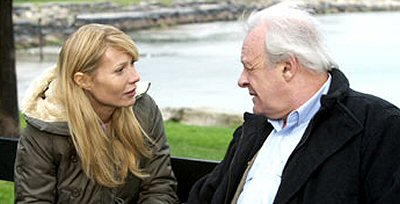
Paltrow, Anthony Hopkins in Proof
I started thinking about Albert Einstein after seeing Proof, and asking myself how exactly did Einstein’s theory of relativity affect the state of things? He expanded our knowledge of the exact properties of time and light and the ramifications of space travel, and he alerted FDR to the work being done by the Germans on building a nuclear bomb…but what does all this fascinating mumbo jumbo in Proof about breaking ground and pushing the mathematical envelope and re-configuring high-level math concepts really have to do with…well, anything?
In dramatic terms it isn’t all that relatable. People always admire pioneers and anyone exploring new turf, but what Hopkins and Paltrow and Gyllenhaal and their friends are all hopped about feels a little bit mysterious and maybe even a little so-whatty.
I’m not for a moment dismissing higher mathematics, but anyone who sees this film will be hard-pressed to come to a conclusion about what it all boils down to from even a semi-grounded perspective.
Of course, all this stuff I’ve been discussing was probably in the play. So why did Harvey even make this thing if he wanted to reach the people who eat dinner at McDonalds?
Re-Selling Cavett
For me and anyone else who loved watching “The Dick Cavett Show” on ABC from ’69 to ’74, the pleasures of the show were primarily about inquisitiveness, urbanity and cultivation. The idea was to entertain and get ratings, etc., but always with an aura of class.
You could always count on Cavett’s witty humor and his having these intoxicating, extra-brainy conversations with his fascinating guests, who tended to reside above the level of Don Rickles. And then there were the wild incidents (like Lester Maddox walking off the show when Cavett refused to apologize over some blithe remark) that would happen from time to time.
But these aspects of the show are perhaps a bit too challenging for today’s audiences. This, at least, is the decision of a distributor called Shout! Factory, which will be issuing a series of Cavett DVDs over the next five years.
I got wind of this after running into Cavett on Lexington Ave. last Wednesday and we got to talking about Shout’s first DVD package coming out later this month called The Dick Cavett Show: Rock Icons.
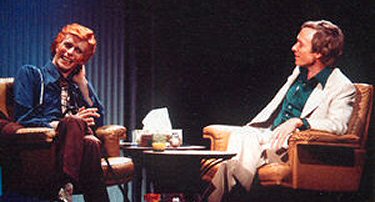
David Bowie speaking to Dick Cavett sometime during the his Ziggy Stardust phase, probably in ’73 or thereabouts.
It’s basically footage of ’70s rockers like Janis Joplin, David Bowie, George Harrison, Sly And The Family Stone, Stevie Wonder and others performing on his show, plus some conversation.
The following day (i.e., yesterday) I spoke to Robert Bader of the L.A.-based Shout! Factory. Bader said he’s been watching tapes of the Cavett show for the last 18 months and that he’s looking very much forward to turning on new generations of fans to Cavett’s sublime talent as a celebrity interviewer and late-night wit.
But he said something disturbing as well, which is that after looking at the tapes his conclusion is that Cavett’s literary-cultural shows don’t entertain as well as the others.
On top of which he has to “sell” these shows to the Shout! marketers, so basically they’re putting together packages that are more broadly marketable. Packages, in other words, that will attract people who shop at Target.
The “Rock Icons” collection comes out on August 16th, followed by a collection of Ray Charles shows (three shows, 14 performances of songs) on 9.13, a DVD devoted to guest appearances by John Lennon and Yoko Ono (due in November), and then a “Comedy Icons” package that’ll be out sometime in the first quarter of ’06.
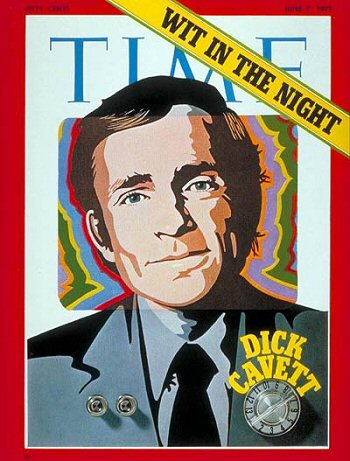
Dick Cavett as he appeared on cover of Time‘s 6.5.72 cover story, published at the apex of his popularity and influence.
Then, if Bader pitches them well and other packages sell decently, we’ll see “Hollywood Legends” (Marlon Brando, et. al.) and “Great Filmmakers” disc sets. Neither of these has been confirmed with the marketing people but Bader is going to push for them.
Which is all well and good, but if you ask any fan about the “Dick Cavett Show,” they’ll all say it was the show’s intellectual and cultural and sometimes political discussions that were the prime signature.
It’s what separated Cavett from Johnny Carson, who, sharp and funny as he was, was always a man of conservative Nebraskan sensibilities and mainstream showbiz tastes. In today’s terms, Carson had the reds and Cavett had the blues. Cavett’s show was a slightly more uptown Charlie Rose with laughs and an audience…a slightly less downscale David Letterman.
Bader says some of the writers and cultural types I’m interested in will be woven into tapes featuring rock stars and guests like Mickey Mantle and John Wayne so all is not lost, but obviously the chances of seeing Cavett DVDs of those famous shows with Gore Vidal, Norman Mailer, Truman Capote and other literary types are not high right now.
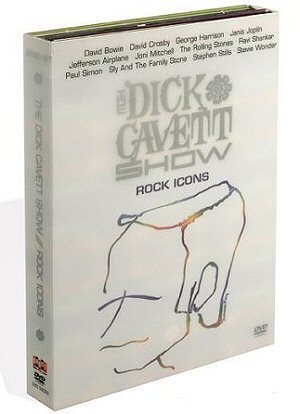
The Dick Cavett Show “Rock Icons” DVD set, being issued by Shout! on 8.16.
Bader is a smart guy and knows what he’s talking about. He’s also a realist in terms of the marketplace and what he can get the company to release.
“The reality of the present marketplace is not to be dismissed lightly in matters like releasing ‘The Dick Cavett Show’ on DVD,” he says. “We feel that we have an extremely valuable commodity and are carefully working out our releases in order to put out as many sets as possible. I think it would be safe to say that we don’t want to put out a set that sells 5,000 copies right now. We would not get too far into our planned series of releases if that were to happen.”
Bottom line: a beloved late-night showcase of comic wit, urbanity and sophistication in the early ’70s, a show that reflected to some extent the turbulence and cultural upheavals of that era, is being repackaged to modern DVD viewers as…I’m tempted to say as an upscale “Ed Sullivan Show.”
No would argue that mainstream America is a much more conservative and reactionary culture today than it was in the ’70s, and all of that lefty-intellectual New York conversational stuff from the ’70s probably won’t play that well in 2005 Peoria…if in fact it ever did.
We all know that a DVD needs to sell to “red” America if it wants to end up in the black, and the cultural dissolution that has occurred in this country over the last 30 years is not a myth. It may be a clich√É∆í√Ǭ© to say that we were a brighter, more inquisitive, more intellectually alert nation back then…but we were.

I’m glad these DVDs are coming out, but I have to say I’m more than a tiny bit disappointed.
The film industry has produced two Truman Capote movies over the last year or so. The first, Bennett Miller’s Capote (Sony Pictures Classics), will debut at the Toronto Film Festival and hit theatres in late September. Then comes Douglas McGrath’s Have You Heard? (Warner Independent), but not until the fall of ’06.
Obviously there are producers and distributors who are convinced that there’s some kind of decent-sized audience out there that knows and cares about Capote and who he once was.
It therefore seems odd that a celebrated TV talk show that was (a) known for its intellectual edge, (b) had Capote on a few times and (c) is issuing commemorative DVDs of its glory days isn’t, right now, thinking about including the appearances of Capote and other literary types who were grandly associated with this show in its heyday.
In fact, the more I think about it, the more depressing it seems.
“If I put out ten shows with authors as the main guests at the start of our release cycle, I can assure you we’d be in deep trouble,” Bader admits. “You and I might be dying to see Tennessee Williams chat it up with Dick but by and large the public that purchases these things finds Dick’s incoherent chat with Sly Stone infinitely more entertaining.”
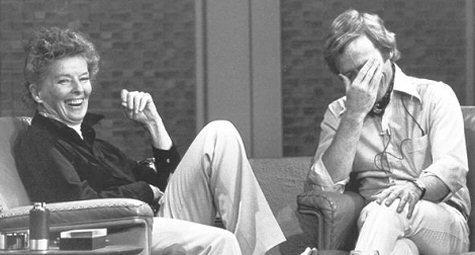
Katherine Hepburn during show that Cavett devoted entirely to interviewing her and her alone.
Rainfall
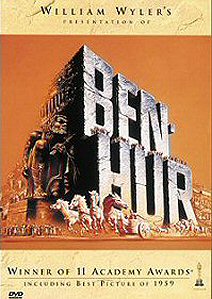

Jacket art for DVD of William Wyler’s Ben-Hur six or seven years ago (l.) and jacket art for upcoming four-disc version (r.). The obvious difference is that arid ancient Judea, where most of the film takes place, has become a much greener place.
Wilson-Flynn
“While I agree that Owen’s a little — make that very — thin-skinned for telling his lawyers to suppress the Butterscotch Stallion T-shirt, I’m not so sure about your question regarding Errol Flynn. He hated not only the phrase ‘in like Flynn’ but every joke that mentioned him. In fact, he hated comedians in general (other than Jimmy Durante, who didn’t do Flynn jokes). I learned all this from his posthumous autobiography, which the publisher entitled…’In Like Flynn.’ Hey, he was dead.” — Kevin Kusinitz, New York, NY.
Wells to Kusinitz: Nope…incorrect. Flynn’s autobiography was called “My Wicked Wicked Ways.” And none of the Flynn biographies I’ve discovered online were called that.
John Lennon vs. Italians
“You wrote in your WIRED item about Don Scardino’s Lennon Broadway show that’s opening on 8.14 that ‘anyone whose name ends with a vowel would probably get John Lennon wrong anyway.’
“Dude, what the fuck is that all about? You’ve been administering a pretty fair amount of vitriol to one contingency or another for quite some time, but really, what are you actually trying to say with that? I’m sure there is some sort of half-cocked generalization to be made about folks whose last name is some sort of pointless pluralization as well, but why make the effort? Focus, dude.” — Brian McIntire.
Wells to Mcintire: I was basically saying that the odds are against a New York-area Italian-American like Don Scardino really and truly understanding who and what John Lennon — a working-class Brit from Liverpool — was deep down. It takes blood to know blood.
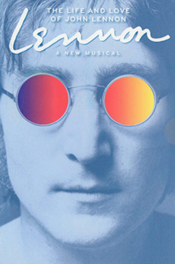
Spike Lee made the same point about ten years ago when he argued that Norman Jewison was the wrong guy to direct a biopic about Malcolm X…that a black director like himself felt and understood things about Malcolm X’s life that were beyond Jewison’s ability to see or properly dramatize.
I don’t think Scardino can get Lennon any more than Lennon, when he was alive, could have been expected to write an authentic song about the Italian doo-wop music culture that arose from New York City area in the 1950s.
And by the way, here’s a portion of a news story about the delay of the Lennon show: “When asked about speculation that David Leveaux (Fiddler on the Roof, Nine) was brought in to replace director Don Scardino, a production spokesperson said that Leveaux ‘is a friend of the production and has offered support to Don Scardino and the creative team.'”
The word is that the show is dreadful and will probably close before too long.
Grabs
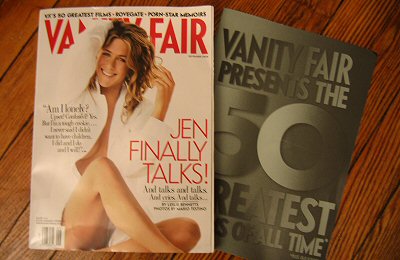
The new Vanity Fair “50 Greatest Films of All Time” supplement in the Jennifer Aniston issue is rather whore-ish. It’s like an advertising supplement for Turner Classic Movies, which has bought all the advertising. The great film choices are fine (I’ll go with Old School as one of the 50…as some kind of perverse joke) but the writing is totally rote, like something pulled out of a Golden Retriever video catalogue.

I figure it’s okay to say I had lunch at Cafe Boulud on East 76th Street on Wednesday with screenwriter and industry spitballer William Goldman (All The President’s Men, Misery, Marathon Man). We just talked about stuff…nothing for attribution. Nobody…knows…anything.

The formidable Trevor Jett Wells, deep in thought and trying to bang out an assignment for a journalism pre-college course at NYU — Sunday, 7.31, 7:55 pm.

Very cool bar on First Avenue near 3rd or 4th Street.

Lobby of the Carlyle Hotel — Wednesday, 8.3, 2:45 pm.
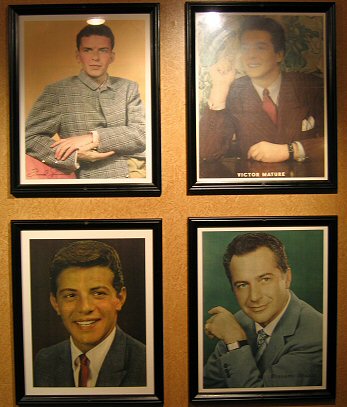
If you dont know these faces….
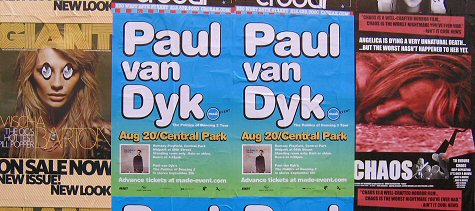
Wildposts on 15th Street near 8th Avenue — Tuesday, 8.2, 5:50 pm.

Old snaggle-tooth…fearsome but kinda cute in a brute-beast sort of way.
The more I think about that snaggle tooth sticking out of the mouth of Peter Jackson’s big ape, the more uncomfortable I feel. (Go to “photos” on the official website.) It’s a hint, you see…a very slight indication of the emotional tone of Jackson’s King Kong. That tooth doesn’t exactly say “cute,” but it’s obviously a kind of message from Jackson to his fans that says, “Cut this guy some slack…I mean, he can’t go to a dentist, can he? Consider the vulnerability.” The tooth, in other words, is about intimacy and warmth. I’ve been saying it all along, but this movie is going to be trouble. I could be dead wrong and I hope I am. Jackson’s Kong may reanimate or infuse fresh energy into that occasionally spooky and haunted vibe that Merian C. Cooper created in his original 1933 Kong, but I seriously doubt it. I smell a valentine. This isn’t going to be about a ferocious chest-pounding ape and a blonde he’s fallen for, but about a movie myth digitalized into some textural intrigue here and there (I love the snow on the streets of New York during Kong’s rampage there) but mostly a slicked-up and essentially sentimental Peter Jackson theme ride. If it were going to be about something truly primal and fearsome, that tooth wouldn’t be popping out like that. I’m sorry but it’s really that simple. This movie is going to be about Jackson chaperoning the relationship between his ape and the audience in the same way Alfred Hitchcock was always a presence in his films, always sitting next to us and at the same time “playing” us like an organ. The all-new Kong is not going to consider what it might be like to be covered in the stench of an ape’s breath — it’s going to be about distance and aesthetics and all the money and massive power that Jackson has acquired from his success with the Rings, and the indulgence this has afforded him.
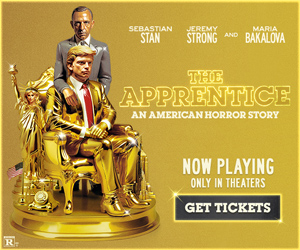
The unfortunate Jackson auteurist element aside, most of us are still keen on seeinng the new King Kong and especially the new Warner Home Video double DVD of the original 1933 film coming out on 11.22.
Owen Wilson telling his attorneys to stop the sale of that
Butterscoth Stallion T-shirt a day or two ago (which I didn’t even hear about until yesterday) is, of course, character-revealing. Wilson sounds very Zen and witty-cerebral in interviews, but he’s obviously thin-skinned about this aspect of his ascension. It’s a very special, very hard-to-achieve thing to become a kind of legend of the boudoir…for people in Oklahoma and Shanghai and Nairobi to assume a certain familiarity with your exploits and talk about you in…okay, in a joshing way, but also as a swordsman deserving a certain respect. How many actors have managed this in Hollywood history besides Errol Flynn? Would Flynn have stopped the sale of “In Like Flynn” T-shirts if there had been a slogan T-shirt market in the 1940s or ’50s? I’m not saying Wilson is “wrong” to want to try and suppress this whole Butterscotch Stallion thing. Maybe I’m under-acknowledging the clownish echoes. I’m saying this kind of notoriety (and really is a kind of flattery, I feel, at the end of the day…I’m really not going into an aloof put-on mode) is rare.
I don’t know USA Today columnist Whitney Matheson and I figure she’s got to have one or two things on the ball to land a gig with a serious nationwide publication, but her stuff is depressingly shallow, inane…it’s like a parody of a writer with some depth who’s decided to put everyone on and pretend they’re the emptiest, least interesting GenXer in the history of the planet. Really, read some of this shit…it’s mind-bending.

This Mary McNamara piece in the Los Angeles Times is hilarious. It’s basically a woe-is-me complaint about Focus Features having given her a mere 45 minutes to sit down with director Jim Jarmusch and discuss Broken Flowers at the Chateau Marmont a few days ago. She says Jarmusch loosens up only at the very end, when there’s five or ten minutes to go. Well, it’s always this way. McNamara is spoiled — most of us get a lousy 20 minutes. It’s been like this since…oh, roughly the late ’80s? Mid ’80s? I did an article for Empire in 1990 about interviewing Elizabeth Perkins for 15 minutes about her work in Alan Rudolph’s Love at Large. I wrote it like a ticking-clock suspense thing…13 minutes to go…11 minutes to go…seven!…three!
Hot Date
The youngish producers of a little movie called My Date With Drew (DEG, 8.5) — Jon Gunn, Brian Herzlinger, Brett Winn and Kerry David — have gone through an exhilarating ride as well as a cold and lonely one for the last 20 months or so, and it’s all been paradoxical.
All the buyers liked or loved Drew but all but one said no to a theatrical release because they felt it looks and feels too much like reality TV. And yet there’s no question this indie thing plays with 30-and-under audiences, and I mean in a big way.
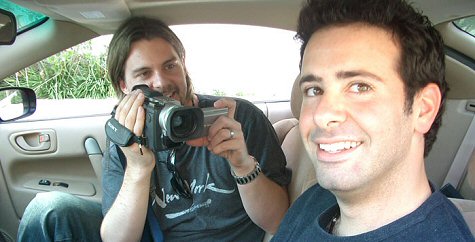
My Date With Drew producer Jon Gunn, producer-star Brian Herzlinger.
I’ve seen Drew three times with a crowd, and I especially felt the excitement when I saw it a year and a half ago at the Vail Film Festival. Each time it’s made people smile, laugh, tear up, cheer. It’s one of the few films out this year that delivers a genuine emotional high, and when a film works as well as this one does it doesn’t matter what it resembles.
What matters is the heart and soul of it. For most people, the emotional-spiritual stuff is what sells tickets…if they hear the right things from their friends, that is.
There’s no reaching the gorillas who automatically see the latest piece-of-shit studio movie every weekend…Dukes of Hazzard, Stealth, The Island, etc.
< ?php include ('/home/hollyw9/public_html/wired'); ?>
But there’s a whole ‘nother demographic out there…people with the ability to step outside the lab-rat syndrome in selecting films, people with a semblance of focus and inquisitiveness and a touch of emotionality…these are the ones who will presumably get Drew and turn it into something.
This surprisingly disarming 30-and-under date movie finally opens in theatres (in New York, Los Angeles, Chicago and Dallas) on Friday, and then will fan out from there.
Here are the basic facts, and when I say “facts” I don’t mean impressions and/or opinions that I feel should be regarded as factual because I have this subjective fervor, blah, blah.
Drew is about this amiable, thick-bearded, beagle-eyed guy named Brian Herzlinger who, back in ’03, tried like hell to somehow land a date with Drew Barrymore…with the steady help of Gunn, Winn and David.
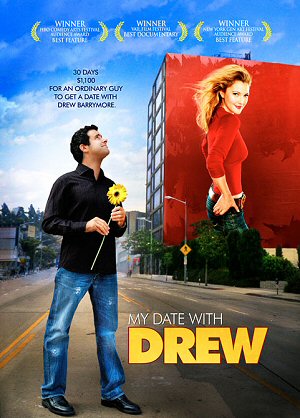
Brian’s been a Drew worshipper since he was 6 years old or something, but this is vaguely depressing to some of us so let’s not dwell.
They’ve got only $1100 to invest (which Herzlinger has won on a game show) and 30 days to get the date, since the camera they’re shooting with has been “bought,” in a manner of speaking, at a Circuit City store in Los Angeles that was offering a 30-day, no-questions asked return policy.
So Drew is a ticking-clock thing as well as a docu-comedy, but it gradually grows into something more….although it’s initially hard to see how this will happen, given an implicitly trite (although extremely well edited) blast-off section that sets everything up.
The film shows the crew using their limited Hollywood connections to get to anyone with the slightest relationship to Barrymore, including a cousin, a skin treatment specialist, Corey Feldman (who “went out” with her when she was 10), Charlie’s Angels screenwriter John August and actor Eric Roberts.
At the same time Herzlinger and David repeatedly call Barrymore’s Flower Films to try to persuade her “people” (especially company team-leader and closest Drew confidante Nancy Juvonen) to watch a 30-second trailer about the project, which of course they refuse to do.

This is standard Hollywood blow-off behavior for people who work for big-name celebs — saying no is always easier and less threatening than saying maybe, and keeping would-be invaders out of the inner sanctum and thereby maintaining a sense of cocooned reality is, of course, always the main priority.
All kinds of stuff happens, but the effort finally pays off when the team creates a website and the numbers get bigger and bigger and the smug-heads at Flower Films eventually wake up and pay attention.
To me, at first, Herzlinger seemed like a putz. What semi-intelligent male would come to a conclusion that spending two or three hours (or whatever amount of time it would eat up) with a rich, over-pampered, Hollywood ego princess like Drew Barrymore is worth sinking his heart and soul into? Not to mention all his financial resources?
But guess what? It doesn’t matter. This is not a film about Drew Barrymore. This is a film about gumption, positivism, tenacity, and working with your friends to somehow make your dream come true. It manages to pay off in ways that are largely unexpected and curiously shrewd. It’s a little-engine-that-could movie that sends you out shaking your head with amazement and wearing a big dumb grin.
Without getting too specific, it can be revealed that Barrymore does make an appearance in the film, and it struck me the last time I saw it that My Date with Drew is easily the most emotionally engaging thing she’s appeared in for quite a while.
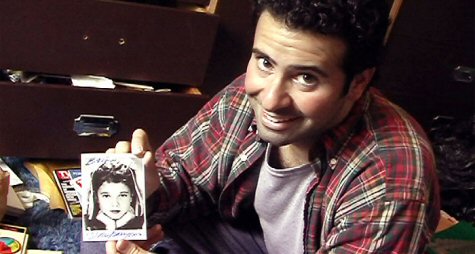
What was Barrymore’s last half-decent movie? Confessions of a Dangerous Mind? Riding in Cars With Boys? Neither of these films makes her seem as lovable and well-rounded as she is in My Date with Drew. In fact, this $1200 video pic is almost enough to erase memories of the two Charlie’s Angels films. For Barrymore, Drew is a major karma-balancer alongside these lasting abominations.
Naturally, of course…Barrymore hasn’t done a single thing to help promote the Gunn-Herzlinger-Winn-David film.
Before the launching of the Iraq War a certain Fox Searchlight exec declared that Drew is too TV-ish and lacking in real-movie substance to warrant a theatrical run. Maybe she’s right — maybe Drew will fizzle like all the naysayers have predicted all along — but even if it does she and others like her will have still missed the point.
This movie has it where it counts. It delivers an emotional payoff that truly sinks in. See it this weekend and tell me I’m wrong.
Herzlinger, Gunn, Winn and David not only made a nifty little film, but they’ve parlayed its notoriety into the beginnings of industry careers, so good for them and a pat on the back for having the pluck and moxie that anyone needs to make it in this town.
Witness
“While on a camping trip last week in Kanaskis Country in Alberta, Canada, my family and I were about to go on a hike around Upper Lake (about an hour away from Calgary) when a guy with a walkie-talkie came running up and politely asked us to move as we were in the shot of a movie they were filming. It turned out that in the middle of the Canadian Rockies we had stumbled onto the outdoor set of a new Robin Williams comedy called RV.
“Williams plays an overworked man who abruptly loads his family into an RV en route to Colorado, hoping they won’t discover he is actually going there to attend a business meeting. It’s being directed by Barry Sonnenfeld. The costars include Jeff Daniels and Curb Your Enthusiasm star Cheryl Hines (i.e., Larry David’s beleaguered wife).
“We asked if we could watch some of the filming and the walkie-talkie said sure. So we took some pictures and now you’re running one that gives away one of the big sight gags!
“We got to see Robin chase his RV down a hill and then watch as it sinks into the lake. W e also got to see him film a dialogue scene right after he gets out of the water. His wife asks him why he needs a $4,000 bike, and he says its because his hips are out of alignment. She then asks if she is happy now because his kids know their dad is a freak.

“They were using 2 RVs. The one parked at the top of the hill and a separate one already sunk in the lake with the back half of it still sticking out of the water rigged with a cable holding it in place. When they filmed the scene the cable was released and the RV started to sink completely under water as Robin chases it. We later saw this one after it was pulled out of the water and it was just a shell with nothing inside.
“Robin looked to be in good shape and was clean shaven. He wore a green shirt and kakhi pants. He and Cheryl both had doubles on the set dressed like them but the doubles just sat around and never got involved. Robin gamely ran into the water numerous times and it was very cold. We got to see Sonnenfeld direct. He was wearing a white cowboy hat and smoking a cigar.
“We took our hike after the crew shut down for the day. Near the top of a mountian there was an open area which my daughter scanned with binoculers, and she saw a grizzly bear was rambling along the top of this ridge, probably looking for berries to eat. It was awesome…. the real reason we went camping.
“It was kind of amusing to think about the cast and crew being driven back to the comfort of their hotels while we headed back to our campsite in the woods.” — Charles Buckner
Larson’s Song
“I don’t see why everyone is blaming director Christopher Columbus in advance for the possible failure of Rent (Columbia, 11.11). I mean, it’s Rent! Sugar bleeds from this thing.
“If you should blame anyone, blame Jonathan Larson, the author and composer. It’s really horrible the way he died and all, but there’s kind of a reason it took him so long to bust through.
“He workshopped it too much and he really didn’t know too many people in the biz so funds and staging were a constant problem.
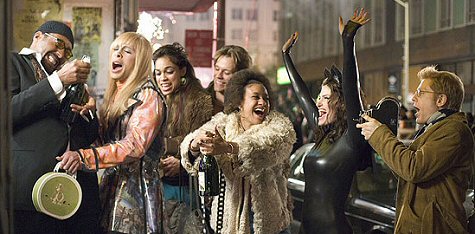
The cast of Christopher Columbus’s Rent
“Another factor is that the lyrics to most of the songs sound like he wrote them in his diary, like a teenage girl would write during a slumber party…fluff tunes that would make everyone happy and given them something to perform and be forgotten later, but remembered fondly in their later years.
“If Larson had lived, he could have seen the off-Broadway premiere of Rent and had that for comfort. I remember when that play came out — you could not turn on the TV without hearing how he died and the success of Rent.
“There are only two types of people who like Rent: (a) hipster types who listen to bland pop music, and (b) depressed individuals who need a severe pick me up.” — Alfred Ramirez, Fort Worth, Texas.
Herzog
“I’m looking forward to Grizzly Man (Lions Gate, 8/12). Shit, Herzog’s been blowing my mind for almost 30 years, and there are powerful forces at work in any universe in which someone can make a film like “Aguirre” at the age of 29.
“At the same time I’m not buying his Herzogian disingenuousness about not including the audio tape of the bear attack because he’s “not making a snuff film.” First, that negates the definition of “snuff film.” Second, while I haven’t seen the film, I can clearly picture the scene you’ve described: of Herzog listening to the tape on camera, and then telling the owner to burn it.

Grizzly Man director Werner Herzog
“And the way I’m picturing it, at least, this is likely to be every bit as disturbing, albeit in a different and more director-calculated way, than the tape itself. And perhaps more so? I mean, start with ‘less is more’ and go on from there. Of all the possible uses Herzog might have made of this tape in his film, isn’t this the one that seems the most Herzogian? (I promise I will never write, or say, “Herzogian” after this email.)
“To me, the most haunting and disturbing image in Herzog’s Aguirre, the Wrath of God was that of the young Spanish noblewoman, dressed in her absurd 16th century finery, walking trance-like into the jungle after she discovers her husband has been assassinated, while a battle rages around her.
“She’s committing suicide — either by wild animal, starvation, or who-knows-what at the hands of the natives — but clearly, SHE DOESN’T CARE, and Herzog simply shows the jungle closing around her. I have pondered the realities of her fate so many, many times since I first saw that film.” — Josh Mooney
Gripe
“What’s with all of the critique of women in the WIRED posts the last couple of times?” — James Kiehl
Wells to Kiehl: Whatsername in the Toronto paper wrote the thing about Jessica Simpson — I just commented on it. And MSNBC’s Eric Lundergaard wrote his piece about sexy women and I just riffed on it…what?
Kiehl to Wells: It doesn’t really seem to be your forte. That Lundergaard article was kinda crappy, but the least you could have done was counter it with five sexy women of your own to prove the point. Just criticizing a critic seems silly, especially when you are a critic yourself.
Wells to Kiehl: I did post a favorite…Anouk Aimee in the ’60s and ’70s!
Kiehl to Wells: Anyhow, don’t you remember when Britney acted like Jessica does now? We loved her.
Wells to Kiehl: I didn’t! She’s a lame-o!
Kiehl to Wells: This is not some seismic shift to the dumb blonde worship. We’ve been there for years. Marilyn Monroe, anyone?
Wells to Kiehl: Monroe played “dumb blonde,” but by the mid ’50s it was evident in her performances and off-screen behavior that she was hurting big-time on a personal level, and that gave her soul. Plus she attended Lee Strasberg’s New York class plus she married Arthur Miller, etc. Monroe was a full meal and a complicated wreck, aching and striving and having breakdowns and all that. Jessica and Britney are little pieces of drug-store candy compared to her.
Grabs


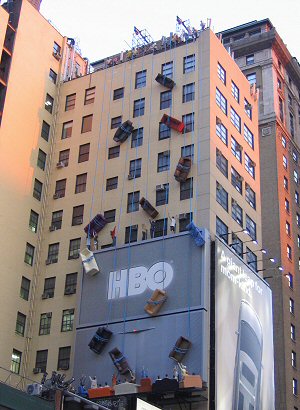


How much do you want to bet that Don Scardino’s Lennon musical, due to open on Broadway on August 14th, will totally ignore the central point of John Lennon’s life? You’d have to figure anyone whose name ends with a vowel would probably get John Lennon wrong anyway, especially with Yoko Ono’s support and cooperation being part of the bargain, but the central point is this: the combustability and diamond-sharp edge in the creative output of any genius is often accompanied by personal unhappiness or chaos of one kind or another, and once this artist tries to bring order, mental positivism and serenity into his/her life as an end in itself, it usually means that his/her best work has already been produced. Most of the Pollyanna’s hate this viewpoint because it argues with their belief that positive outlooks are essential components, but it’s true. Once Lennon found personal happiness with Yoko Ono and withdrew into the Dakota and became a good father to Sean and all that domestic stuff, he was finished as a major artist. He was said to be “unhappy” when the Beatles first started to get rolling in ’63 until their breakup in ’69 or thereabouts, but he was at his creative peak all through most of this period. (Same point made by Orson Welles in The Third Man about the productivity of the tumultuous Italians vs. the ordered Swiss.) Art is not about being happy and serene.
All right, I’m sold…Lord of War (Lions Gate, 9.16), a snarky-attitude comedy about weapons dealers, is going to be a guilty pleasure. The trailer had me grinning from the get-go, and toying with the possibility that Andrew Niccol’s film is better than William Freidkin’s Deal of the Century (’83), which trod on the same turf. Nic Cage, Ethan Hawke, Jared “large wang” Leto and Bridget Moynahan are the leads in the newbie. The only thing that scares me is the fact that Niccol also directed Simone, which was the worst piece of shit Al Pacino’s ever been in. But seriously, the trailer is very cool. My favorite bit: a guy in a gray suit comes up to Cage, flashes his ID and says, “We’re with the Bureau of Alcohol, Tobacco and Firearms.” And Cage wearily replies, “And this is not about the alcohol and tobacco.”
I haven’t seen Steven Greenstreet’s This Divided State yet, but it looks like a pretty good red-state-vs.-blue-state doc and we’re all into that, right? It’s opening at San Francisco’s Victoria theatre on 8.4 (wait a minute…isn’t that a Thursday?) and will open at New York City’s Quad on 8.19 and at the Fairfax on 9.9 and a lot of places in between. If anyone’s seen it and wants to throw me a review, please do. And it’s okay if you’re a red-state bubba and you think it’s crap or ungodly…just write it like you feel it.

<div style="background:#fff;padding:7px;"><a href="https://hollywood-elsewhere.com/category/reviews/"><img src=
"https://hollywood-elsewhere.com/wp-content/uploads/2019/08/reviews.jpg"></a></div>
 Really Nice Ride
Really Nice RideTo my great surprise and delight, Christy Hall‘s Daddio, which I was remiss in not seeing during last year’s Telluride...
More »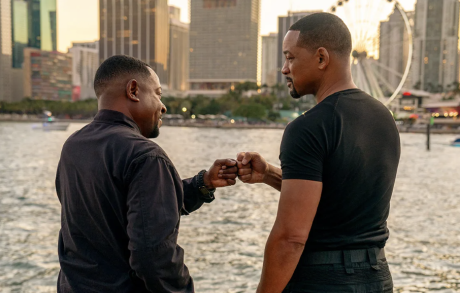 Live-Blogging “Bad Boys: Ride or Die”
Live-Blogging “Bad Boys: Ride or Die”7:45 pm: Okay, the initial light-hearted section (repartee, wedding, hospital, afterlife Joey Pants, healthy diet) was enjoyable, but Jesus, when...
More »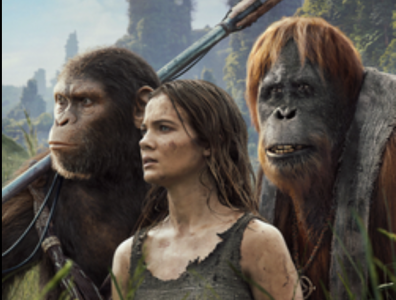 One of the Better Apes Franchise Flicks
One of the Better Apes Franchise FlicksIt took me a full month to see Wes Ball and Josh Friedman‘s Kingdom of the Planet of the Apes...
More »
<div style="background:#fff;padding:7px;"><a href="https://hollywood-elsewhere.com/category/classic/"><img src="https://hollywood-elsewhere.com/wp-content/uploads/2019/08/heclassic-1-e1492633312403.jpg"></div>
- The Pull of Exceptional History
The Kamala surge is, I believe, mainly about two things — (a) people feeling lit up or joyful about being...
More » 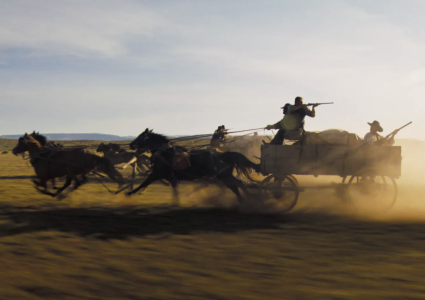 If I Was Costner, I’d Probably Throw In The Towel
If I Was Costner, I’d Probably Throw In The TowelUnless Part Two of Kevin Costner‘s Horizon (Warner Bros., 8.16) somehow improves upon the sluggish initial installment and delivers something...
More »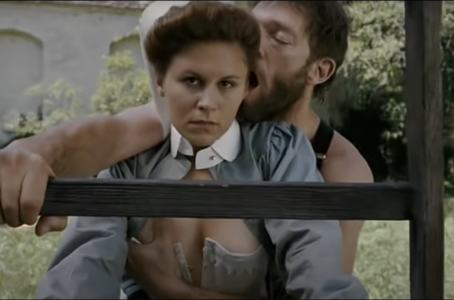 Delicious, Demonic Otto Gross
Delicious, Demonic Otto GrossFor me, A Dangerous Method (2011) is David Cronenberg‘s tastiest and wickedest film — intense, sexually upfront and occasionally arousing...
More »



